#bronze age gold
Explore tagged Tumblr posts
Text






Recreation of the Bronze Age Bush Barrow Burial, Wiltshire Museum, Devizes
Britain’s richest Bronze Age burial in around 1950 BCE
#ice age#stone age#bronze age#iron age#prehistoric#neolithic#prehistory#mesolithic#paleolithic#bronze age gold#gold#design#geometry#wealth#archaeology#burial#barrow#burial chamber#burial mound#burial ground#Wiltshire#ritual#bush barrow burial
75 notes
·
View notes
Text









🤎◾️⚜️◾️🤎Immortals of Stars🤎◾️⚜️◾️🤎
#gifs(edits) made by me :)#assassin1513#mystical#mystic#stars#to infinity and beyond#beyond#beyond the stars#glitter#bronze#brown#vintage#cosmos#galaxy#space#outer space#moon#moonchild#moon aesthetic#moon and stars#history#history aesthetic#histoire#void#space aesthetic#gold#gold aesthetic#golden#golden aesthetic#golden age
1K notes
·
View notes
Text

(1973)
#Scooby Doo#comic book#1973#Mystery Comics#Shaggy#Velma#the Ghosty Goose#Gold Key comics#vintage#1970s#bronze age#comic books
160 notes
·
View notes
Text

BORIS KARLOFF TALES OF MYSTERY #41 (Gold Key, 1972).
Art: George Wilson
#gold key comics#horror#horror comics#pulp#pulps#pulp horror#pulp art#bronze age#bronze age comics#george wilson#comics#comic book#comic art#70s comics#70s comic books#1970s comics#1970s comic books#boris karloff#karloff#mystery#mystery comics
116 notes
·
View notes
Text
Reyna, upon learning about some shenanigans Piper and Leo got into: Piper, what were you thinking?
Piper: *glaring at Jason and Leo* Okay, which one of you told my girlfriend about this?
Leo: *sweats*
Leo: I’m sorry! She scares me!
#leo valdez#piper mclean#reyna avila ramirez arellano#heroes of olympus#hoo#incorrect HoO#pipeyna#piper and Leo#incorrect pjo#incorrect quotes#platonic liper#I’ve not done these in ages but I was looking at one of my old blogs and this one would not leave my mind#lost trio#I’m gonna need a quartet tag for these four at some point I have so many thoughts#Celestial gold#I think I’m going with that one as a mix between celestial bronze and imperial gold
57 notes
·
View notes
Text


Source
#text#autismposting#stim#stim toys#agere#stim toy#agere stim#my gifs#gold stim#agere community#age regressor#age regression#agere safe space#agere blog#sfw agere blog#sfw agere#sfw age regression#sfw age regressor#bronze stim#smb stim#star stim#shiny stim#irl hands tw#up close#pacifer stim#paci stim#deco paci stim#deco pacifier stim#deco stim#cute stim
43 notes
·
View notes
Text
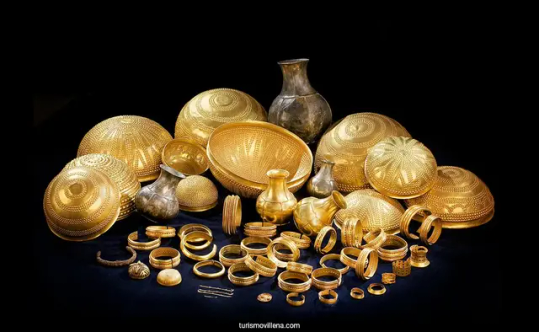
Meteorite Iron Discovered in 3,000-year-Old Bronze Age Gold Hoard
New research reveals that two Bronze Age artifacts from the Treasure of Villena contain iron from a meteor that hit a million years ago.
In the ’60s, researchers discovered a trove of Bronze Age treasure in Villena, Spain. While most of the stunning bottles, bowls and bracelets are made of gold and silver, new research has revealed that some of them were forged from another material: iron from a meteor that struck Earth a million years ago.
According to a recent study published in the journal Trabajos de Prehistoria, researchers conducted tests on two of the artifacts—a bracelet and a hollow decorative sphere—made between 1400 and 1200 B.C.E.
The trove’s materials have long mystified researchers. After finding it on the Iberian Peninsula in 1963, archaeologist José María Soler García noted the presence of a “dark leaden metal” among the gold, per El País’ Vicente G. Olaya. The metal was “shiny in some areas, and covered with a ferrous-looking oxide that is mostly cracked.”
To determine the iron’s origins, researchers used mass spectrometry, a technique that measures a molecule’s mass-to-charge ratio. As Live Science’s Jennifer Nalewicki reports, this analysis revealed that the iron’s nickel composition resembles that of meteoritic iron. These items are the first artifacts made of meteoritic iron ever found in the Iberian Peninsula.

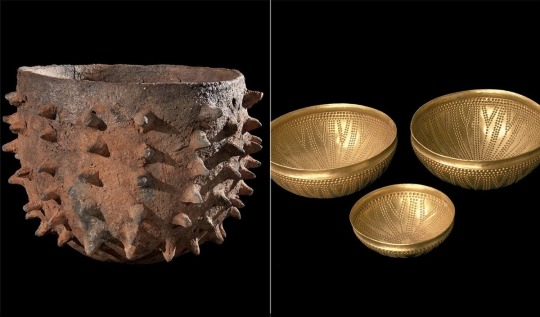
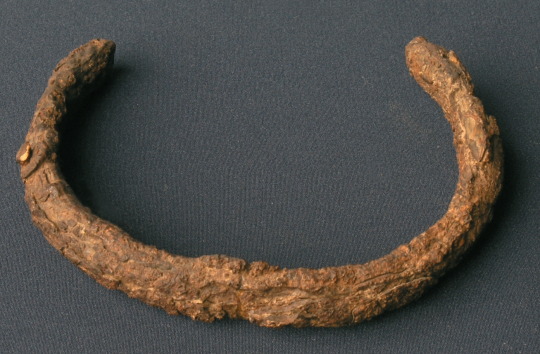
“Iron was as valuable as gold or silver, and in this case [it was] used for ornaments or decorative purposes,” study co-author Ignacio Montero Ruiz, a researcher at the Spanish National Research Council’s Institute of History, tells Smithsonian magazine.
The presence of such an “unusual raw material” suggests it was made by highly skilled metalworkers capable of “[developing] new technologies,” adds Montero Ruiz.
But iron is also quite different from more common materials such as copper, gold or silver. As Montero Ruiz says to Live Science, “People who started to work with meteoritic iron and later with terrestrial iron must [have had to] innovate.”
The study’s other co-authors are Salvador Rovira-Llorens of the National Archaeological Museum and Martina Renzi of the Diriyah Gate Development Authority. The trove is held by Villena’s Archaeological Museum, which says on its website that the 66 items are considered the “most important prehistoric treasure in Europe.” Still, the artifacts’ origins remain a mystery.
Montero Ruiz tells Smithsonian magazine that objects made from meteoritic iron are rare, and most known examples from this period are connected to eastern Mediterranean cultures. The treasure’s creators “probably had access to a fallen meteorite in the area that allowed them to discover the properties of this material and how to shape it,” he says.
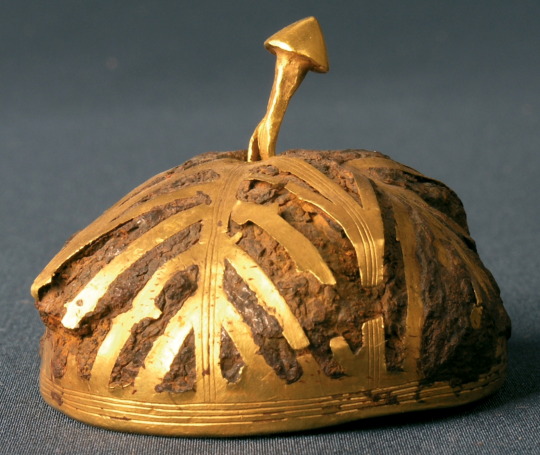
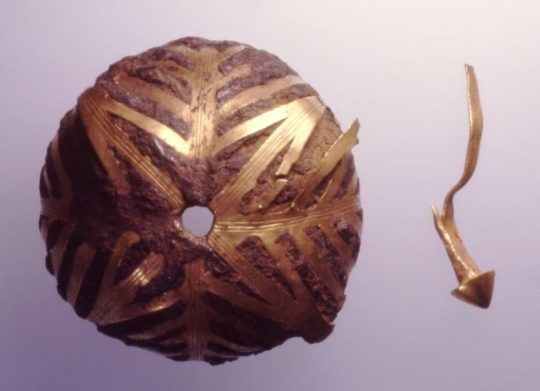
Last year, research revealed that an arrowhead found in Switzerland was made from meteoritic iron. That artifact, however, dates to between 900 and 800 B.C.E.
Researchers also don’t know who owned the Villena treasure, though they think it would have belonged to a community rather than a single individual.
“These two pieces of iron had enormous value. For this reason, they were considered worthy of becoming part of this spectacular ensemble,” says Montero Ruiz, per El País. “Who manufactured them and where this material was obtained are still questions that remain to be answered.”
By Sonja Anderson.


#Meteorite Iron Discovered in 3000-year-Old Bronze Age Gold Hoard#Treasure of Villena#Bronze Age treasure#Bronze Age#gold#silver#ancient artifacts#history#history news#ancient history#archeology#ancient civilizations#ancient art
145 notes
·
View notes
Text

Featuring the chilling tale "The Monster Bird That Pooped Down My Chimney!"
53 notes
·
View notes
Photo


Tutankhamun's meteoric iron dagger,
Also known as Tutankhamun's iron dagger and King Tut's dagger, is an iron-bladed dagger from the tomb of the ancient Egyptian Pharaoh Tutankhamun (reigned c. 1334–1325 BC).
As the blade Composition and homogeneity closely correlate with meteorite composition and homogeneity, the material for the blade is determined to have originated by way of a meteoritic landing.
Since the 1960s, the high nickel content in the blade has been accepted as indicative of meteoric origin. A more recent study published in June 2016 derived from x-ray fluorescence spectrometer analysis show that the blade's composition is mostly iron (Fe) and 11% nickel (Ni) and 0.6% cobalt (Co). This means its composition is placed within the median of a group of 76 previously discovered iron meteorites.
The nickel content in the bulk metal of most iron meteorites ranges from 5% to 35%, whereas it never exceeds 4% in historical iron artifacts from terrestrial ores produced before the 19th century.
Also, the nickel to cobalt ratio of this blade is comparable to that of iron meteorite materials.[2]
At the time of King Tutankhamun's mummification in approximately 1323 BC (the Bronze Age), iron smelting and manufacture were rare. Iron objects were used for only artistic, ornamental, ritual, gift giving, and ceremonial purposes as well as for pigmentation. Hence, iron during this age was more valuable or precious than gold.
The dagger is currently displayed at the Egyptian Museum in Cairo
#art#design#Egypt#dagger#blade#meteorite#iron#tutankhamun#bronze age#alien#gold#king tut#style#history#nickel#cobalt#artifacts#ritual
330 notes
·
View notes
Text
aw, balls. I put off my take home final until this week because I've been out of sorts, and I was going to take today to relax and gather myself, but I forgot the deadline and the deadline is today.

#Considering asking the prof for an extension which would be kinda dumb but I think the recent death is hitting me harder than I thought.#Not really an excuse. Also I did worse on the makeup exam than I thought I would which is very annoying. I need to do a bunch of#practice stoichiometry if I want to get better at this. c'est la vie. the chapter of Thing I've been working on will have to wait.#You know I just looked over at my shelf and I have this text: Greek Gold. I have to read up on early MesoAmerican gold mining#particularly in Venezuela and Peru. I have this Ecuadorian thesis on mining around Quito that's on the list next. But after that when I wan#to tackle Greecian silver I do have that book on my shelf already which is pretty fucking handy.#My professor confirmed they did amalgamation in the later part of the Iron Age which... part of me wonders if that adds to the complexity#around the Bronze Age Collapse? That'd be extremely interesting.#I'm glad I can ramble to tumblr about this and you guys don't mind the bits and pieces because I can't rant to anyone in person. <3#It's really comforting to be able to infodump here.#Aside: Apparently 'stoichiometry' was not in my web dictionary and spellcheck wanted to turn it to stylometric (???)#ptxt
12 notes
·
View notes
Text

Bronze Age Shale Button With Gold Cover, Wilsford, Barrow G8, Wiltshire Museum, Devizes
Shale button or pendant encased in sheet gold, decorated with four bands of incised lines. The heavy wear on the holes at the base suggest it was either sewn to clothing or worn around the neck as a pendant.
#ice age#stone age#bronze age#iron age#prehistoric#prehistory#neolithic#mesolithic#paleolithic#bronze age gold#archaeology#metalwork#metalworking#ancient cultures#ancient craft#ancient living#button
27 notes
·
View notes
Text
Gold Lion Figurine from Georgia (South Caucasus), c. 2300-2000 BCE: Georgia contains one of the oldest prehistoric gold mines in the world, dating back to about 3400 BCE; researchers also believe that the Greek legend of the "Golden Fleece" was inspired by the goldsmithing traditions found in Georgia

The peoples of Georgia (the country, not the state) have been extracting and processing gold for many thousands of years. Georgia is even home to the oldest known gold mine in the world -- a site known as Sakdrisi, where there is evidence of gold mining operations dating back to about 3400 BCE (roughly 5400 years ago).
Sadly, the prehistoric gold mine at Sakdrisi was damaged (and largely destroyed) in 2014, after a Russian mining company (RMG Gold) was given permission to resume its own mining venture on the site. The full extent of that damage has yet to be determined.
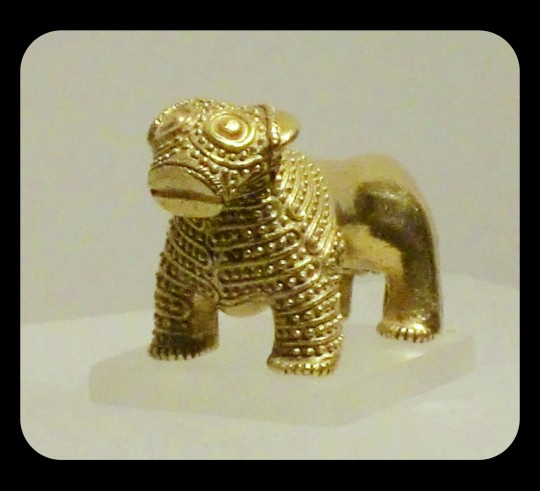
The Tsnori Lion: this figurine dates back to the Bronze Age in Eastern Georgia; it is one of the many artifacts that have come to represent the history of goldsmithing in this part of the Caucasus
The goldsmithing traditions of Georgia also continued to flourish during antiquity, and the ancient Kingdom of Colchis (in what is now Western Georgia) was renowned for both its wealth of gold and its skilled goldsmiths. To the Greeks, Colchis was also known as the homeland of the fabled Golden Fleece -- the treasure sought by Jason and the Argonauts during their mythical voyage into the Caucasus, as described in the Greek Argonautica.
It's believed that the legend of the Golden Fleece may have had at least some basis in reality. Ethnological and historical accounts indicate that the peoples of Colchis/Georgia traditionally used sheepskins to sift for gold in the rivers of the Caucasus; during that process, the fleece would slowly become encrusted with tiny particles of "gold sand," until it eventually took on the appearance of a "golden fleece." Additional research has confirmed that the rich alluvial deposits found within the region certainly would have been sufficient to have produced this "golden fleece" effect.
Researchers believe that those customs may have given rise to the Greek legends about the Colchians and their Golden Fleece -- legends that ultimately evolved into the story of the Argonautica.
The unique goldsmithing traditions of Georgia played an important role in the cultural/political development of the South Caucasus, and those traditions are reflected in the wealth of golden artifacts that have been found throughout Georgia (and elsewhere).
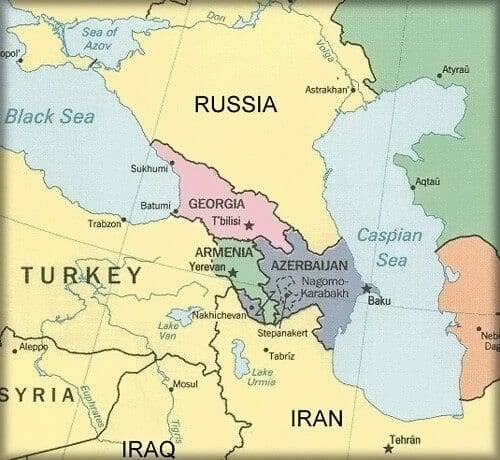
The Location of Modern-Day Georgia: as this map illustrates, Georgia is nestled right at the crossroads between Europe and Asia, with the Black Sea located on one side and the Caspian not far from the other; it is bordered by Russia to the North and Turkey, Armenia, and Azerbaijan to the South
Sources & More Info:
Quaternary International: A modern field investigation of the mythical “gold sands” of the ancient Colchis Kingdom and “Golden Fleece” phenomena
Archaeo Sciences: Bronze Age Gold in Southern Georgia
Britannica: Archaeologists uncover traces of Bronze Age gold workshops in a cemetery near Tbilisi, Georgia
BBC: Artefacts from the world's oldest gold mine
UW Jackson School of International Studies: Georgian environment, heritage at risk as RMG Gold exploits Sakdrisi
UTA Department of Slavic & Eurasian Studies: Ancient Georgia - crossroads of Europe and Asia
Atinati: The Golden Kingdom of Colchis
The Past: Georgia's Treasures: from the Land of the Golden Fleece
National Geographic (Georgian): Golden Lion from Kakheti
Smithsonian: Why this Ancient Civilization Fell Out of Love with Gold for 700 Years
National Geographic's "Out of Eden Walk:" Treasures of the Caucasus
Democracy & Freedom Watch: What was lost when a mining company destroyed the ancient Sakdrisi site?
#archaeology#history#georgia#caucasus#transcaucasia#sakartvelo#artifact#art#lion#iberia#colchis#golden fleece#jason and the argonauts#greek mythology#ancient greece#bronze age#chalcolithic#prehistoric#gold#goldsmithing#conservation#sakdrisi
70 notes
·
View notes
Text

(1973)
#The Occult Files of Doctor Spektor#comic book#1973#Jesse Santos#cover art#Gold Key comics#vintage#1970s#Dr Spektor#bronze age#comic books
120 notes
·
View notes
Text

UFO and OUTER SPACE #21 (Gold Key, 1979)
Art: Chuck Liese
#chuck Liese#gold key comics#gold key#comics#comic books#bronze Age#bronze age comics#bronze age comic books#70s comics#1970s comics#alien#aliens#flying saucer#flying saucers#ufos#pulp#ufology#ufo#aliens and ufos#alien abduction#extraterrestrial#ufo sightings#science fiction#pulp science fiction
21 notes
·
View notes
Text
the more i think abt it the more i think the far right idea of ireland historically being this “pure” island separated from the world around it before its colonisation is just an inversion of british ideas abt ireland which cast it as this backwards place only connected to the world through british influence. and instead of rejecting that framework and investigating the ways in which ancient ireland did play a role in the broader world before colonisation, the irish far right decided that england was completely right about ireland, with the only difference being that they see this mythical isolation as the ideal to be returned to.
edit: i cant believe i have to make this clearer but this post is criticising the irish far right for their hateful and ahistorical beliefs. migration is not colonialism nor is it the cause of irelands problems. it is a morally neutral act.
#bro you are just accepting british paradigms#not to be like we live in a society but.#like do you know how involved ireland was in the transmission and reproduction of texts. do u know abt its tradition of pilgrimage#and the pilgramage sites in ireland that people visited from across the world#(i mean mostly europe and the middle east bc they were christian sites and thats where christians were. but still#but these connections predate christianity#did you know bronze age gold collars from ireland have been found throughout central europe. do you know how amber in ireland. like that in#most of ancient europe. comes from the area around ukraine#i cant emphasise enough how insane the state of the discourse is like. it seems like a lot of people really believe in this past which#never existed#sorry i watched some smarthistory videos abt ancient and medieval irish art and got mad#be quiet b
9 notes
·
View notes
Text
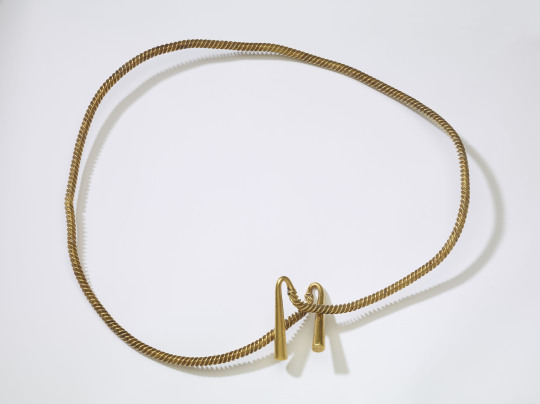
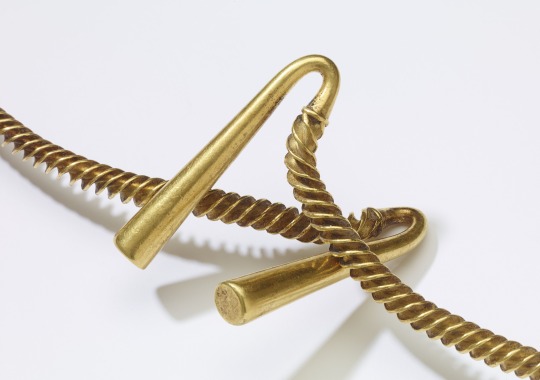
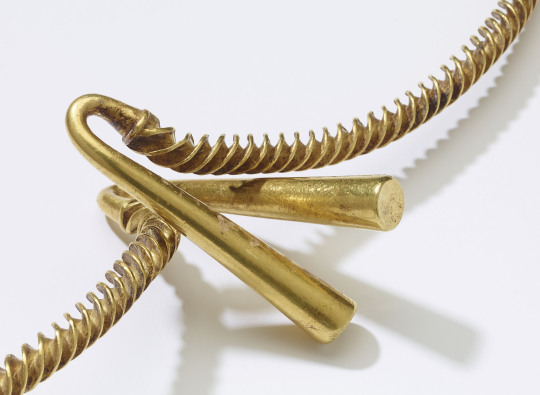
Massive Bronze Age Gold Torc Stolen From Ely Museum
Curators are "devastated" after gold objects dating back 3,000 years to the Bronze Age were stolen from a museum.
A gold torc and a gold bracelet were stolen during a break-in at Ely Museum on Tuesday.
The museum acquired the torc, valued at £220,000, in 2017 using grants and donations and it said the loss was a "huge blow".
Cambridgeshire Police said it was looking for two suspects on e-scooters who were believed to be involved in the burglary.
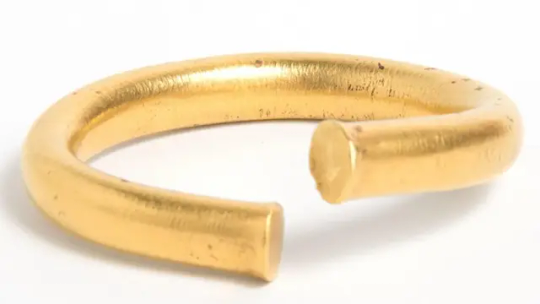
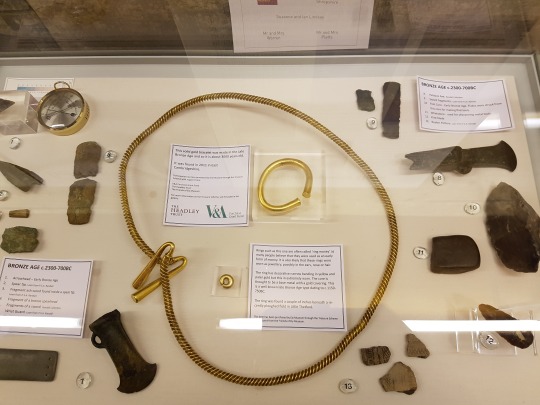
'Cannot be replaced'
Elie Hughes, a museum curator, said: "We are devastated by the loss to the museum and to the local heritage of the region.
"It is a huge blow after the incredible support from the community in acquiring the torc in 2017.
"As a culturally significant object, it cannot be replaced. Our priority now is working with the police to locate the stolen objects."
Both items were found in East Cambridgeshire by metal detectorists.
The torc, found in a ploughed field, is regarded as the best found in England in more than a century as it is larger than many other examples and made of 730g (1lb 10oz) of almost pure gold.
Det Insp Kiri Mazur said: "The theft of these items is despicable and we are focused on identifying the offenders, tracing the items, and returning them to their rightful place.
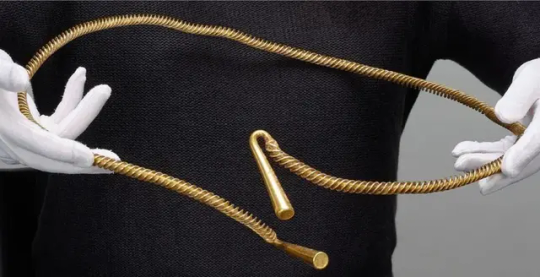
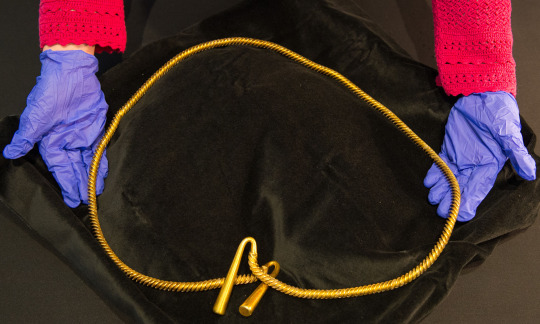
"We are working closely with staff at Ely Museum to follow all lines of inquiry.
“I am very keen to hear from anyone who may be able to provide information or saw two people on e-scooters who were in the vicinity the museum, car park and pedestrian walkways at the back of the museum, the council offices and the Grange Car Park, between 12am and 2am [on Tuesday].”
By Harriet Heywood.
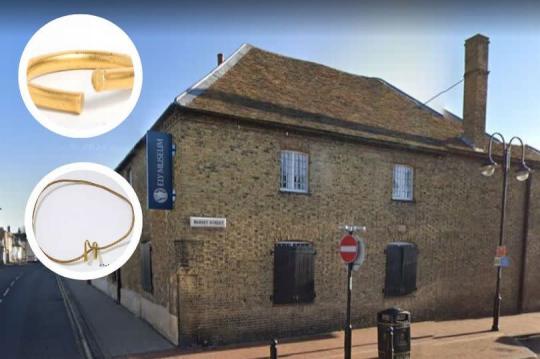
#Massive Bronze Age Gold Torc Stolen From Ely Museum#Ely Museum#gold#gold jewelry#gold torc#gold bracelet#ancient gold#ancient artifacts#metal detecting#stolen#stolen art#looted art#archeology#archeolgst#history#history news#ancient history#ancient culture#ancient civilizations#bronze age#ancient art
26 notes
·
View notes